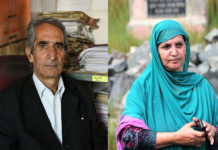By Muhammad Luqman
The prevalence of malnutrition in Pakistan has come down to 19.9 percent from previous year’s 22 percent , according to recently released Global Hunger Index.
But nutritionists believe that Pakistan is still not out of the woods in terms of food security and nourishment as there is an increase in the total number of undernourished people from 35.7 million to 37.6 million over the last one decade.
“Stunting in children less than five years remains very high at 45%, and notable of attention is the prevalence of anaemia rising to 52% of women in reproductive age. This puts a heavy toll on Pakistan’s future,” says Minà Dowlatchahi, the representative for the Food and Agriculture Organization in Pakistan,
Agriculture contributes about 20% of Pakistan GDP, employs 42% of the labour force and is the dominant form of livelihood for the majority of rural households, even 97% of the population in certain areas.
Sindh is in the process of drafting its new agriculture policy, Balochistan drafted its agriculture policy two years ago, although it is still awaiting endorsement. Punjab has developed a draft of the Punjab Agriculture Policy that was presented in March of this year. In Punjab, the vision is of “making agriculture competitive, profitable and sustainable through enablement, efficiency and value-addition for food and nutrition security and socio-economic development”. For the first time the draft policy explicitly links food security and nutrition. Finally, at federal level, the National Draft Food Security Policy has been drafted and is awaiting final endorsement.
According to nutrition experts, inclusive rural development and efforts to revive the agriculture sector will help increase livelihoods incomes and foster economic growth.
“Modernising agriculture and water management while adapting to climate change will contribute to increasing yields and incomes sustainably,” writes Minà Dowlatchahi in an article published in Pakistan’s newspaper, Daily Express Tribune.
Hunger is not restricted to humans in Pakistan. About 75 percent of the livestock especially the milch animals don’t find enough food.
“ We need to promote silage so that the animals could get balanced diet,” says Dr. Talat Naseer Pasha, Vice Chancellor, University of Animal and Veterinary Sciences, Lahore, Pakistan.
Agricultural integrated sustainable systems are central to securing improvements in food security and nutrition and socio-economic stability. Food security and nutrition need socio-economic stability. Approaches and solutions are known, the technology is available. The challenge is securing government and civil society attention to the most vulnerable, to scaling up successful pilots, and to the needed people behavioral changes. This requires consistency of action, adequate resource allocations, coherence and coordination of initiatives at various levels of institutions and stakeholders and across districts. It requires realising the importance of political commitment and working systematically on the ‘soft’ side of planned investments.
To ensure complete food security in this part of the world, innovative practices, investment in green, information technology and farmers behaviors changes are required. In that, decent employment opportunities — which can be generated by productive agriculture and supporting activities ranging from information services, credit provision to storage, marketing and food processing businesses — are needed to convince young people in rural areas to stay and work in agriculture, and contribute to its transformation
Food security issue is not restricted to Pakistan alone as 2017 State of Food Security and Nutrition in the World report says that in 2016 the food security situation deteriorated sharply in parts of sub-Saharan Africa, South-Eastern Asia and Western Asia.
The failure to reduce world hunger is associated with the increase in conflict and violence in several parts of the world in particular where the food security impacts of conflict were compounded by droughts or floods and climate-related shocks. Most of the world’s poor live in rural areas and many rural youth migrate in the absence of productive opportunities and lack of socio-economic stability.
In those areas that have suffered from conflicts and population displacement, interventions related to restoration of productive assets and strengthening of productive skills of returnees and of the capacity of the public and private sector service providers delivered benefits. Together with land reclamation and resilience building activities, these interventions go a long way and have a results-proven track record, to help restore the livelihoods of returnees.















